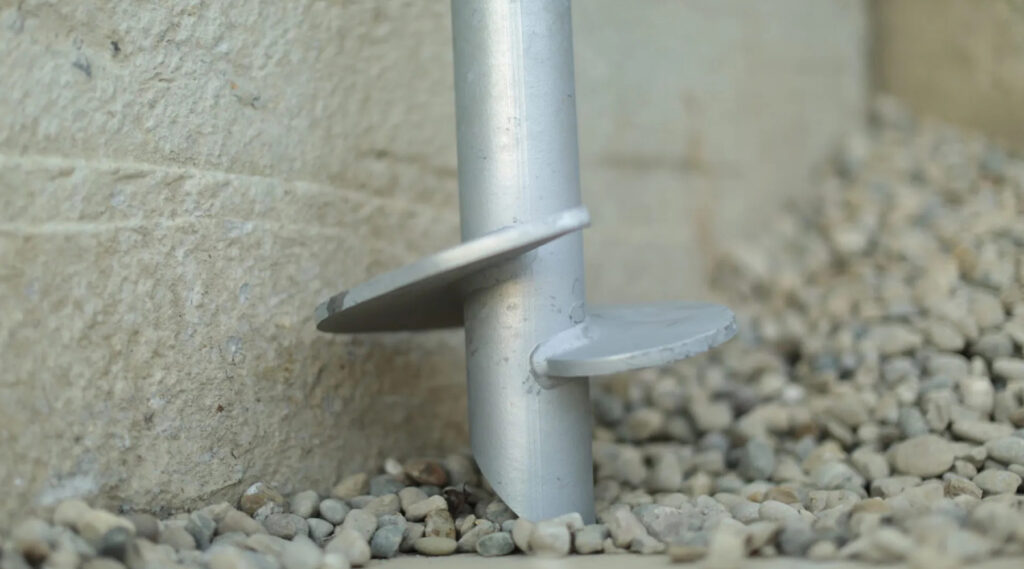With the right knowledge, you can effectively address foundation issues in your home using helical piers. These innovative foundation solutions are particularly beneficial for properties experiencing soil movement or settling. Statistically, around 25% of homes in the United States show signs of foundation distress, making awareness of effective repair options crucial. In this blog post, you will learn when helical piers are the best choice for your foundation repair needs, ensuring your home remains stable and secure for years to come.
What Are Helical Piers?
While addressing foundation issues, helical piers serve as an innovative and effective solution. These deep foundation systems consist of steel shafts with helical plates that anchor into stable soil layers, providing support and stability to your structure. Particularly beneficial in situations where traditional methods may fall short, they offer reliable reinforcement for settling or unstable foundations.
Components and Design
Any effective helical pier system includes a few key components: the steel pier shaft, helical plates, a bracket, and a weight transfer mechanism. The design of helical piers allows them to redistribute the load of your structure to deeper, more stable soil strata. This versatility makes them suitable for a variety of soil types and conditions.
Helical Pier Installation Process
At the installation site, hydraulic machines drive helical piers deep into the ground, ensuring that they reach the ideal load-bearing soil. This process involves assessing the foundation’s needs and determining the appropriate depth and spacing of the piers based on your property’s specifications.
Also, the installation process is relatively swift, often completed in a matter of hours or days, depending on the number of piers required. You can expect minimal disruption to your landscaping since helical piers require less excavation than traditional piers. Studies indicate that a properly installed helical pier can withstand loads of up to 70,000 pounds, making them a robust choice for most foundation repair needs.
Signs Your Foundation Needs Helical Piers
It is necessary to identify when your foundation requires helical piers. Look for signs such as cracks in walls, uneven floors, or doors and windows that are difficult to open or close. These indicators reflect underlying issues that could compromise your home’s structural integrity. These are some of the signs that indicate that you might need to repair your foundation. To get more information about this, have a look at these signs of foundation repair. By recognizing early signs, you can take action to prevent more extensive damage and expensive repairs.
Structural Damage Indicators
Piers can provide support when you observe significant structural damage in your home. Cracks in the foundation, brick-and-mortar separations, or tilting chimneys indicate that your foundation may be settling unevenly. Addressing these signs quickly can lead to solutions that restore your home’s stability.
Soil Conditions Assessment
Behind every foundation issue lies the condition of the soil surrounding it. Soil that expands or contracts, often due to moisture changes, can severely impact your home’s foundation. Assessing soil conditions enables you to understand whether helical piers are necessary to stabilize your structure.
For instance, clay soil is known for its expansive characteristics, which can lead to 10-15% movement in your foundation if the moisture content fluctuates. Suppose your home sits on soil that experiences significant variations in compactness or moisture. In that case, helical piers can provide a reliable solution, anchoring your foundation to more stable soil layers and ensuring long-term support.
Ideal Applications for Helical Piers
Clearly, helical piers are an effective solution for various foundation issues, especially when dealing with unstable soil conditions. These deep foundation systems are particularly beneficial in situations where soil-bearing capacity is compromised, enabling you to stabilize and support structures in diverse environments. Whether in residential or commercial settings, understanding the ideal applications for helical piers can help you make informed decisions for your foundation repair needs.
Residential Projects
Against common misconceptions, helical piers are highly suitable for residential projects, particularly in homes experiencing foundation settlement or shifting soil. When you notice warning signs like cracks in walls, uneven flooring, or doors that won’t close properly, it may be time to consider helical piers as a reliable foundation repair solution.
Commercial Applications
Ideal for commercial applications, helical piers offer a strong and durable foundation solution for structures such as office buildings, retail centres, and warehouses. You will appreciate their ability to be installed quickly and with minimal disruption to your existing site, ensuring that your construction timelines remain intact.
To understand the benefits further, helical piers can support loads of up to 40,000 pounds per pier, making them suitable for various types of commercial structures. Their ability to provide immediate load-bearing support is especially advantageous for commercial projects needing fast-track completion. Additionally, with a track record of success in various soil conditions, you can confidently rely on helical piers to prevent further settling or shifting, ensuring the long-term integrity of your investment.
Benefits of Helical Pier Systems
Not only do helical piers offer a reliable solution for foundation repair, but they also provide significant advantages, including cost-effectiveness and versatility. Their design allows for installation in various soil conditions, making them suitable for many types of properties. Helical piers can be used for both residential and commercial applications, ensuring your foundation receives the support it needs without extensive excavation or disruption to your landscape.
Installation Advantages
At the forefront of helical pier systems are their installation advantages. These piers can be driven deep into the soil with minimal disturbance to your property, allowing for quicker and cleaner installation compared to traditional methods. This means you can return to your daily routine sooner, and you won’t have to worry about excessive restoration work post-installation.
Long-term Performance
With helical piers, you can trust in their long-term performance for your foundation needs. Designed to withstand significant loads, these piers have excellent load-bearing capacity and can adapt to shifting soil conditions, ensuring your structure remains stable over time.
It’s worth noting that helical piers are engineered to provide stability and reduce chances of settlement by transferring weight to deeper, more stable soil layers. In fact, many installations have demonstrated performance well beyond 75 years, showcasing their durability. This longevity not only protects your home or business from potential foundation issues but also provides peace of mind, knowing your investment is secure for the long haul.
Cost Considerations
Many factors influence the overall helical pier cost for foundation repair. It’s vital to evaluate your specific situation, such as the severity of your foundation issues, soil conditions, and the extent of the required repairs. While upfront costs may seem high, the long-term effectiveness and durability of helical piers may save you from further repairs in the future.
Initial Investment Analysis
Initial costs associated with helical piers generally range from $1,000 to $3,000 per pier, depending on your location and the complexity of the project. While this may appear steep initially, it’s important to consider the longevity and low maintenance of helical pier systems that can result in lower overall costs over time.
Comparison with Alternative Solutions
Due to the unique benefits that helical piers offer, including reduced installation time and less disruptive application, they often stand out compared to alternatives. Although methods like slab jacking may be lower in initial cost, they typically do not provide the same level of strength and stability, potentially leading to further issues in the future. Consider this long-term aspect when evaluating your foundation repair options.
Project Planning and Implementation
Keep in mind that successful implementation of helical piers requires meticulous project planning. Start by gathering all necessary information on your property’s condition, soil type, and climate. Engage professionals to assess your foundation’s issues comprehensively, which will shape an effective repair strategy tailored to your unique situation.
Site Evaluation Requirements
Against common assumptions, effective foundation repair relies on thorough site evaluation. You should consider factors like soil-bearing capacity, drainage patterns, and nearby structures that could affect installation. This evaluation helps you understand the extent of the damage and establishes a baseline for determining the necessary repairs.
Installation Timeline
By understanding the helical pier installation timeline, you can better prepare your home for the installation process. Most installations can be completed in one to three days, depending on the complexity and number of piers required. You’ll want to allow some time afterwards for settling and inspection.
And while the installation itself is relatively swift, it’s wise to plan for external factors that may extend the overall timeline. Weather conditions, access to the site, and necessary permits can all impact how quickly your foundation repairs can take place. Proper communication with your installation team will help you manage expectations and ensure that your home is secure as soon as possible.
Final Words
So, when you’re dealing with foundation issues such as settling or heaving, using helical piers can be an effective and long-lasting solution. These innovative piers can support loads of up to 80,000 pounds, making them ideal for a wide range of structures. If your home shows signs of uneven floors, cracks in the walls, or doors that stick, it’s vital to consider this method. Always consult with a qualified professional to assess your specific situation and determine if helical piers are the right choice for your foundation repair needs. To get expert helical pier installation services, consult with Tri-State Waterproofing; we provide reliable helical pier solutions for foundation stability, whether for repairs or new construction. Our expert installation ensures durability, minimal disruption, and long-term support, even in shifting soil conditions.
FAQs
Q: When should I consider using helical piers for my home’s foundation?
A: You should consider helical piers if you notice signs of foundation problems such as cracks in walls, uneven floors, or doors and windows that stick or won’t open. Additionally, suppose your home is situated on expansive clay soil, which accounts for approximately 40% of the U.S. land mass or has a history of flooding or erosion. In that case, helical piers can be an ideal solution to prevent further damage.
Q: How long does the installation of helical piers typically take?
A: The installation of helical piers usually takes one to two days to complete, depending on the number of piers required and the site conditions. Experienced contractors can efficiently install several piers in a single day, allowing homeowners to see immediate changes and providing a quick solution to foundation issues.
Q: Are helical piers a permanent solution for foundation problems?
A: Yes, helical piers are considered a permanent solution for foundation repair when installed correctly. They are engineered for long-term use and can support heavy loads. According to the International Association of Foundation Drilling, they can withstand soil movement and environmental changes, giving homeowners peace of mind for decades. Proper installation and maintenance are vital to ensure their longevity.
Q: What is the average cost of installing helical piers for foundation repair?
A: The average cost of installing helical piers generally ranges from $1,000 to $3,000 per pier, depending on factors like the extent of foundation damage, soil conditions, and the number of piers required. Homeowners should also consider the potential cost savings from avoiding further structural damage; a home with foundation issues can lose up to 15% of its value if repairs are not addressed promptly.




